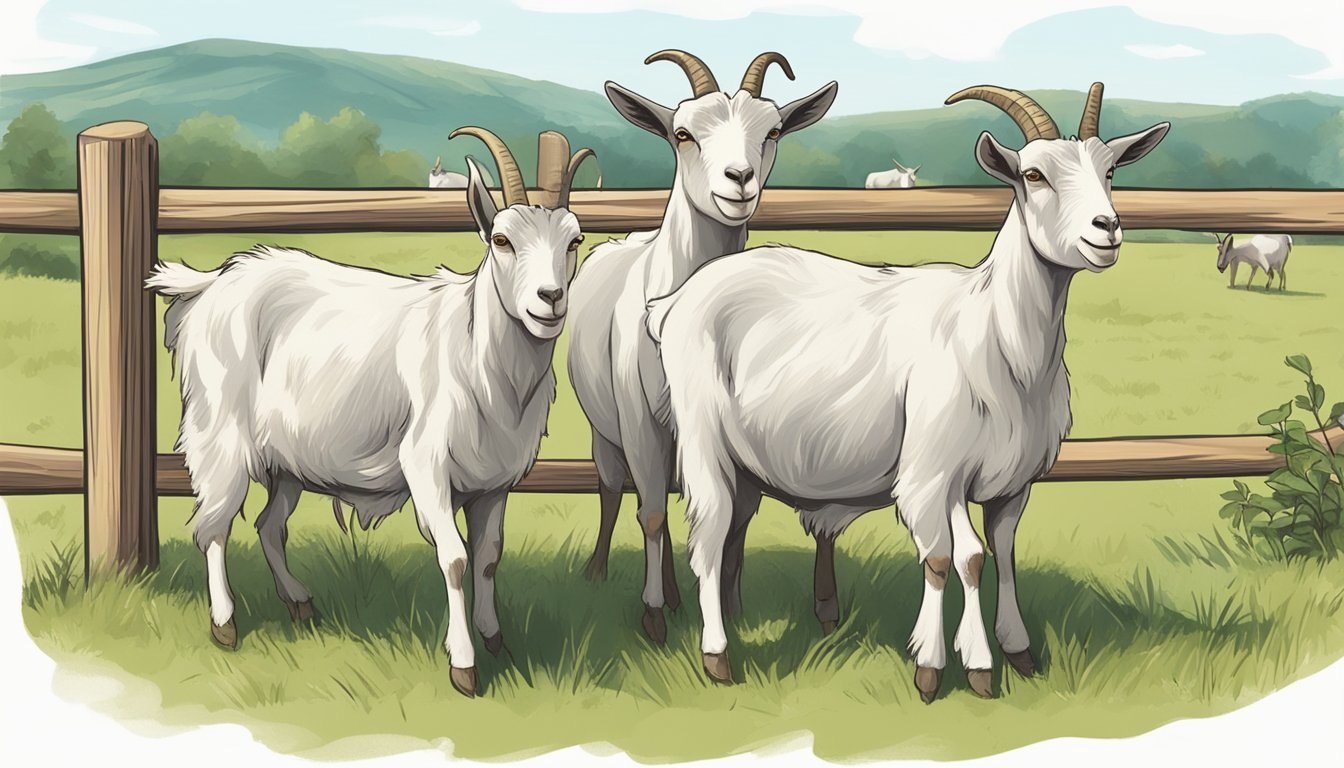What is the Risk of Johne's Disease in Goats?
Understanding the Impact on Herd Health
Johne’s Disease, also known by the scientific name Mycobacterium avium subspecies paratuberculosis (MAP), is a chronic bacterial infection that predominantly affects the intestines of ruminants, including goats. This condition is particularly insidious because it is often subclinical for years, meaning the infected animals may not show symptoms until the advanced stages of the disease. When clinical signs such as rapid weight loss and diarrhea do manifest, it is usually a sign that the disease has progressed significantly, and at this stage, it is typically fatal. The disease represents a risk for goat herds because it is highly contagious and can be transmitted through fecal matter, across the placenta, and via milk to offspring, which makes controlling the spread within a herd challenging.
In goats, Johne’s Disease poses a substantial risk due to the commonality of the fecal-oral spread in herd environments. Though adult goats can become infected, young animals are particularly susceptible to contracting the disease. Infected goats that are asymptomatic can shed the bacteria in their feces, thus contributing to the cycle of infection. The risk of transmission is exacerbated in intensively managed herds where animals are kept in close quarters and hygiene practices may not be sufficient to prevent the spread of the disease.
Management practices and biosecurity measures are critical in reducing the incidence of Johne’s Disease within goat populations. Implementing strategies like ensuring colostrum fed to newborn kids is from MAP-free does, testing and culling infected animals, and improving sanitation can lower the risk of disease spread. Due to the significant impact of Johne’s Disease on herd health and farm economics, goat producers must remain vigilant and informed about ways to minimize risk and manage this challenging health issue.
Understanding Johne’s Disease
Johne's disease is a chronic and often fatal infection affecting the gastrointestinal system of various ruminant species. It poses a significant risk to livestock, particularly in goat herds, due to its insidious nature and challenging management.
Etiology and Pathogenesis
Johne's disease is caused by the bacterium Mycobacterium avium subspecies paratuberculosis (MAP). This pathogen is known to invade the small intestine, leading to chronic inflammation of the intestinal wall. In goats and other ruminants, this results in thickened intestinal tissue which impedes nutrient absorption.
Symptoms and Clinical Signs
Clinical signs can take years to appear, and commonly include progressive weight loss and diarrhea despite a retained appetite. Other signs may include bottle jaw, which is a swelling of the lower jaw due to protein loss, and dehydration. As the disease advances, affected livestock may exhibit signs of severe malnutrition and waste away.
Diagnosis and Testing
Confirming a case of Johne’s involves a combination of diagnostic tests, such as an enzyme-linked immunosorbent assay (ELISA), culture, and polymerase chain reaction (PCR) to detect the presence of MAP. A veterinarian may also perform a physical examination and consider clinical signs. Testing may be directed towards feces, blood, or tissue samples from affected animals.
Epidemiology and Prevalence
Epidemiological studies show that Johne’s disease is prevalent worldwide and affects both dairy and meat-producing herds. The prevalence in goat herds can vary widely, influenced by factors like herd size, management practices, and environmental conditions.
Transmission Routes
Transmission of MAP is primarily through the fecal-oral route, with young animals being especially susceptible. Shedding of the bacterium can occur through colostrum, milk, water, manure, and contaminated pasture. The organism can survive for extended periods in the environment, making control measures challenging.
Disease Progression and Stages
Johne’s disease typically progresses slowly and can be categorised into stages from subclinical to advanced clinical disease. Animals in the early subclinical stage show no visible signs but can still spread the infection. As the disease reaches its later stages, the clinical signs become more obvious and severe.
This detailed understanding of Johne's disease provides a critical foundation for managing the risk it poses to goat herds and other ruminants, ensuring informed decision-making in disease control and prevention efforts.
Management and Control
Effective management and control of Johne's disease in goats are vital for maintaining a healthy herd. Implementing a combination of herd management tactics, environmental strategies, and preventive measures, along with treatment programs and strict testing and culling policies, can greatly reduce the risk and impact of the disease.
Herd Management Practices
To control Johne's disease within goat populations, it is essential to maintain a closed herd, limiting exposure to infected animals. New additions should be quarantined and tested before mixing with the existing herd. Engaging in biosecurity education for all individuals involved in herd care can bolster prevention efforts.
Environmental Management
Environmental control focuses on minimizing contact with infected organic material. Water sources such as ponds should be protected from contamination by infected animals. Pastures and grazing areas need to be managed to minimize the buildup and spread of the Mycobacterium avium subspecies paratuberculosis (MAP) in the environment.
Prevention Strategies
Preventive measures include regular testing and culling of infected animals. While there is no effective vaccination against Johne's disease for goats, keeping a closed herd and raising kids away from adult goats can reduce disease transmission. Practicing sound nutritional management also helps to protect overall animal health.
Treatment Options
No cure currently exists for Johne's disease, and antibiotic treatment is not effective. Thus, treatment is mainly supportive, focusing on maintaining nutrition and appetite to avoid weight loss and economic losses from decreased production.
Testing and Culling Policy
Testing for Johne's disease involves fecal cultures or blood tests, with positive animals being culled from the herd promptly to prevent further spread. Regular testing allows for early detection, which is vital for maintaining a healthy herd.
Disease Impact on Herd Health
Johne's disease can lead to significant economic losses due to reduced productivity, weight loss, and eventual death. Healthy herd management practices are essential for protecting animal health and farming sustainability.
Nutrition and Supportive Care
Nutritious feeding regimes and ensuring access to clean water are essential supportive care strategies for goats affected by Johne's disease. Adequate nutrients can help in maintaining the health of infected animals, potentially slowing the disease's progress.
Implications for Goat Producers
As goat producers grapple with managing Johne's Disease within their herds, they face several multi-faceted challenges. The disease not only affects animal health but also impacts economic stability, public health, industry practices, and necessitates increased educational efforts.
Economic Impact
Johne's Disease can lead to substantial economic losses for goat producers due to decreased productivity. Infected goats often experience loss of appetite and weight loss, resulting in a drop in milk production. The economic implications are two-fold: direct losses from decreased milk production, and indirect costs associated with disease management and prevention efforts, such as vaccination and testing.
Public Health Considerations
The presence of Mycobacterium avium subspecies paratuberculosis (MAP), the causative agent of Johne's Disease, in milk raises public health concerns. Although pasteurization methods like batch pasteurization and flash pasteurization are effective in reducing the risk of transmission, the need for stringent heat treatment protocols is imperative to protect public health.
Goat Industry Challenges
Johne's Disease is not the only disease that goat producers must consider; common diseases such as Caseous Lymphadenitis also pose persistent challenges. Managing multiple diseases requires producers to be highly knowledgeable and deliberate in implementing biosecurity measures to safeguard their livestock.
Educational and Awareness Efforts
Continuous education is critical for goat producers to stay informed on the best practices for disease management. Awareness campaigns and resources on proper farm hygiene, early detection of Johne's Disease, and preventative measures, including vaccination, are essential components to controlling the disease's spread. Producers must keep abreast of up-to-date information and guidelines to maintain herd health and productivity.
Scientific and Research Perspectives
The scientific community is actively engaged in improving the understanding and management of Johne's Disease in goats through advancements in diagnostics, preventive measures, vaccine development, and exploration of future research avenues.
Advancements in Diagnostic Technologies
Diagnostic tests play a crucial role in the detection of Johne's Disease. Recent developments have seen the use of Polymerase Chain Reaction (PCR) technology, enhancing the capability for early detection in ruminants. PCR tests offer rapid and sensitive identification of Mycobacterium avium subspecies paratuberculosis, the causative agent of Johne’s Disease, directly from tissue or feces.
Studies on Transmission Prevention
Research into preventing transmission of Johne's Disease is indispensable for establishing environmental biosecurity. Studies emphasize the importance of interrupting the pathogen's lifecycle to reduce incidence. This includes strategies such as improving sanitation to manage contaminated manure and ensuring that young ruminants are protected from exposure to MAP-infected adults.
Vaccine Research and Development
Vaccine research for Johne's Disease in goats is directed towards stimulating immunity to curtail infection rates. Current efforts are analyzed to produce a vaccine that provides long-term protection while minimizing interference with the diagnosis and control of other mycobacterial diseases. This complex task involves evaluating multiple vaccine candidates and immunization protocols.
Future Directions in Johne’s Disease Research
Future research on Johne’s Disease is geared towards a holistic approach that includes the development of better treatment options and the exploration of the disease's zoonotic potential. Understanding genetic factors contributing to susceptibility in goats and advancements in herd management practices are expected to play pivotal roles in controlling the disease.
Conclusion
Johne’s Disease poses a substantial health risk to goats, with implications for the broader agricultural community given its chronic and often fatal nature. Effective management and control strategies are essential to prevent its spread, as they are directly linked to flock productivity and welfare.
Prevention of Johne's Disease begins with sound biosecurity measures, including:
Testing and monitoring herd health regularly
Isolating and culling infected animals
Implementing hygienic breeding practices
For goat producers, the focus should be on reducing exposure, especially in young animals, as they are more vulnerable to infection. The implementation of a comprehensive control program involves:
Ensuring clean and dry birthing environments
Feeding kids pasteurized milk or colostrum to prevent transmission
Implementing controlled grazing to minimize contact with contaminated pasture
Continuous education on Johne’s Disease and its impact is crucial for farmers and those in the goat industry. Awareness and understanding facilitate better decision-making and adoption of recommended practices.
In sum, while there is no cure for Johne’s Disease, proactive management can mitigate risks. It is in the hands of producers and veterinarians to work collaboratively toward controlling this disease for the sustainability and health of goat populations.




